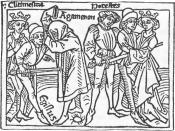The Orestia is about justice; its transformation from theancient, guiltless, bloody animal-like instincts of violent revenge, to therational and emotionless justice as administered by a court and jury. Orestes is representative of thistransition, slaughtering his mother and her lover in revenge and then laterbeing freed of guilt by the verdict of a jury in Athens. Before this justice can be rational, it mustbe emotional. This is the justice asexercised in and prior to The Eumenides. For this emotional (often revenge-like) justice, the gender iskey in determining the roles of victim and aggressor, suggesting perhaps a fatewhich is inevitable when one takes on a particular gender role. The gender role need not be the same as theactual gender of the participant; often the man is effeminate, or the woman masculine. Regardless, the man is portrayed as theaggressor, and the woman as the victim. This portrayal continues until finally the emotional and rational formsof justice diverge far enough apart to become distinct, which does not happenuntil the trial in The Eumenides.
Before the actions specific to TheAgamemnon take place, we are informed of a prior event which is of crucialimportance to The Orestia: the sacrifice of Iphigeneia by her fatherAgamemnon. This single event acts as acatalyst to everything which follows it, creating a seemingly endless spiral ofmurder and revenge which finally stops with the trial of Orestes. Agamemnon is faced with a decision, eitherhe is to sacrifice his daughter Iphigeneia to appease the goddess Artemis forthe children who will die in the battle of Troy, and get favorable winds tohead into battle, or not sacrifice Iphigeneia and lose his honor and not getthose favorable winds. Both choiceswill lead to a bad end, and Agamemnon realizes this when he says "Painboth ways and what is worse?" (Agamemnon, 212). Without much debate Agamemnon decides...


